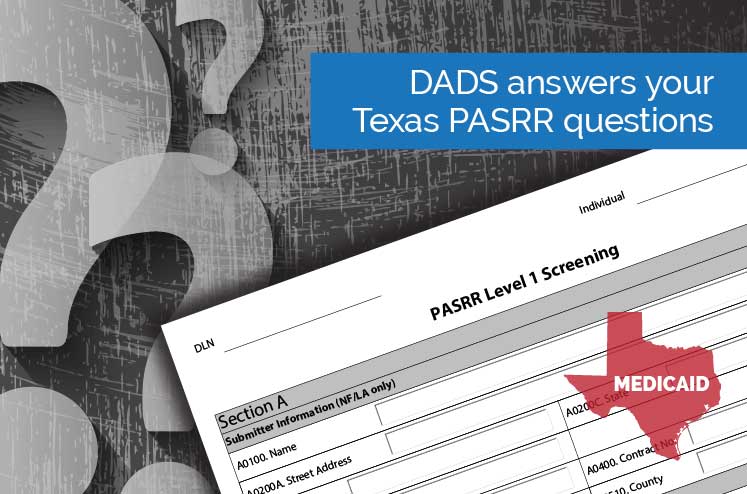On Oct. 13, the Texas Department of Aging and Disability Services (DADS) and SimpleLTC presented a free webinar for Texas long-term care providers entitled, “Texas PASRR: What you need to know NOW”. (Watch it on-demand here.) Hundreds of SNFs from all over Texas participated.
Dozens of questions were asked and answered during the training, but there were many more that couldn’t be covered due to time limitations. So SimpleLTC has worked with DADS get answers to all of those questions and we’re now publishing them here as a service to Texas providers.
All the answers below were provided directly by DADS (with the exception of the questions referring to SimpleLTC software). For additional information about Texas PASRR, see the DADS PASRR resources site or SimpleLTC’s Texas PASRR resources page.
1. Do I do another PL1 for mild MR or under-development status that MDs write in their progress note?
If you feel that the PL1 was submitted in error as negative for IDD, email the DADS PASRR unit.
2. Do we do a PL1 for respite care?
Yes. If the individual leaves on or before the 14th day of respite, please enter “discharged” and the date of discharge on section B0650 and B0655.
3. Do we enter a DC or deceased date on all residents or just PASRR-positive residents?
Enter for all positive PL1 with a status of “Awaiting PE.” This stops the alert to the LIDDA to perform the PE.
4. Do we do a new PL1 even when someone is just discharged to hospital and a return is anticipated?
If the individual is in the hospital for 31 days or longer, a new PL1 is needed.
5. Do you count illness diagnosed prior to the age of 22 (such as depression) as a positive PASRR?
Any suspicion of Intellectual disability, related condition and/or mental illness can be used to create a positive PL1. The PE completed will either confirm or deny the suspicion. A list of related conditions and the definition of related conditions is found via the link located on the PL1 Section C0300.
6. Does the MDS assessment trigger a positive PL1, if PL1 obtained by referring person was not positive?
No. The MDS may trigger an alert when there’s been a change in condition when a new PE may be needed but it will not create a positive PL1.
7. For inaccurate PL1s (such as a negative PL1 that should be positive), whom do we contact? Local Authority?
If you feel the PL1 submitted as negative for ID or DD is not correct, email the DADS PASRR unit.
8. How long does a patient have to be discharged before doing another PASRR on admission?
If the individual has been discharged for 30 days or less to an acute care hospital, no new PL1 is needed. If the NF discharges the individual from the NF on a 3618, a new PL1 is needed. Individuals who leave the facility on approved therapeutic leaves and return (as described in TAC, Title 40, Part 1, Chapter 19, Subchapter AA, 19.2603) do not require a new PL1.
9. I have not entered any of the IDT meetings we’ve had in the last couple months. Is it OK to enter them now?
For any IDT for a positive PL1 and a positive PE from 7/7/15 forward, the IDT needs to be entered into the portal. Review your records and enter any outstanding PEs as soon as possible. Notify the LIDDA/LMHA that the IDTs have been entered to allow them time to certify the IDT.
10. If a patient admits to a facility under (MCR A) skilled stay as PL1-positive, and a PE is done and indicates specialized services are needed, is the patient eligible for those specialized services while they are still skilled or do they have to be a long-term care patient?
The specialized services are identified in the IDT. Private pay is an option for those who can afford it. If they transition to Medicaid, then the PASRR SS are initiated.
11. If a person with medical power of attorney (MPOA) does not want PASRR services for someone who is IDT-positive, how do they decline services? We have been told that the MPOA has to have guardianship, not just MPOA.
A person with a legally authorized representative (LAR)/full guardianship, who has all legal rights to act on behalf of an individual and has current documents (a copy should be kept in the individual’s file), may make decisions regarding PASRR services. MPOA or medical or financial guardianship may not act on behalf of an individual for non-medical or non-financial matters. Some MPOAs stipulate the authority to act on behalf of an individual only when the individual is incapacitated and the MPOA is then authorized to act under life-threatening situations.
12. If a positive PL1 resident goes to the hospital for 72 hours, do I do a new admit PASRR?
See #4.
13. If someone is discharged to another facility, the RE’s PASRR will inactivate the prior one automatically. Does the nursing facility still need to inactivate the previous PASRR?
No. If the PL1 is already inactivated by the entry of another PL1, there is no need to take additional action.
14. If the PL1 you receive has information making the person PASRR-positive and you know it is not correct, what should the facility do?
A positive PL1 cannot be changed; the PE will confirm or deny the PL1.
15. If the resident has Part B, should we bill that first before billing PASRR Medicaid services?
An individual may need rehabilitative services and if they are dual-eligible, Medicare should be billed for all rehab services. An individual may need habilitative services and if they are dual-eligible, the authorization requests should come to DADS PASRR. MCOs do not approve PASRR Specialized Services for habilitative services.
16. Is it a requirement that all IDT meetings are entered into the portal or is this for new admissions that are PASRR-positive?
For any IDT for a positive PL1 and a positive PE from 7/7/15 forward, the IDT needs to be entered into the portal. Specialized Services should be reviewed at least annually.
17. Is the IDT meeting different from the 14-day care plan meeting? Our facility conducts 14-day care plan meetings with residents, plus weekly IDT meetings.
The IDT is a different meeting than the 14-day care planning meeting.
18. Is there a mandate on where the PL1 is filed? Our current policy is in the resident’s financial file. Should we change it to the clinical file?
Texas Administrative Code Rule §19.1911 regarding the contents of the clinical file states (b) The clinical record of each resident must contain: the results of any Preadmission Screening and Resident Review conducted by DADS. We interpret the rule to mean “DADS or their contractors.” Individuals who need access to PASRR forms will expect to see all PASRR records in the clinical file. These records include the PL1, the PE, the IDT and all records concerning Specialized Services.
19. Our facilities are transitioning to an EMR. Can we store the PE electronically in SimpleLTC’s software rather than keeping a printed copy on the chart?
See #18.
20. For residents in the facility prior to new IDT meeting requirements, do we need to go back and do new care plan meetings to meet this requirement or just start with new admissions?
See #16.
21. What do I do when most of my admissions come from jail or assisted living? They say they have no idea what a PASRR is.
The NF may print a blank copy of the PL1 and assist the referring entity with filling out the form.
22. What if a respite comes from home? Who does the PASRR?
The family should fill out the PL1 form (with the help of the nursing facility, if needed).
23. What if we have residents who have been in the facility prior to PASRR but they don’t have a PL1?
All individuals should have a PL1 form. Please check your records and enter a PL1 for those who don’t have one.
24. What is the time frame for IDT meeting if a person is admitted and has a positive PL1, but you are unsure if they are positive for PE?
The IDT can’t be held until after the PE has been completed and the PE is positive.
25. What should you do when you have exhausted all efforts to obtain a PL1 from the referring entity? It was to come with hospital discharge but did not and they are not responding.
For issues with hospitals not providing the PL1, contact DSHS by email. Include the name of your facility, your contact information, the name of the hospital and the attempts you’ve made to obtain the PL1.
For issues with all other referring entities not providing the PL1, contact DADS by email. Include the name of your facility, your contact information, the name of the referring entity and their contact number, and the attempts you’ve made to obtain the PL1.
Please note: You should not admit without the PL1.
26. When a patient is admitted into a facility and the receiving facility is unable to obtain a PASRR from the referring facility, can the receiving facility complete one?
See #26. DADS or DSHS will provide you with information on how to resolve the issue with the PL1.
Please note: You should not admit without the PL1.
27. When do we do an IDT on a resident with a PE? Is it upon admission, quarterly or every time they readmit?
See #16. If an individual has been discharged to a hospital for longer than 30 days, a new PL1 is needed and a new IDT.
28. What do we do if we overlooked the IDT and resident has been here for a while? Where do we enter the IDT?
See #16. Anyone with a PL1 dated 7/7/15 or after with a confirmed positive PE should have an IDT entered.
- In TMHP portal: The IDT is a tab located on the PL1.
- In SimpleCFS: IDT forms are attached to their respective PL1 forms in SimpleLTC software. To create an IDT form for an IDT-eligible PASRR Positive PL1, click on the Actions options on the PL1 form and choose “Create IDT.” Follow the instructions on the form and choose Submit when the form is complete. Once the IDT form has been submitted, its history will be logged beneath the form history of the PL1. From the history view of the form, the IDT form can be clicked on to be viewed and printed.
29. When PASRR comes from the referring entity with incorrect information (name, SSN, etc.) when compared with the CWF or Medicaid information, how do we handle? Notify hospital and ask to send correct information on PASRR?
For recent PL1s from the referring entity, you can ask that they correct the PL1; however, changing demographic information such as the information noted above is an acceptable practice for the NF. Section C of the PL1 should not be changed without the referring entity or DADS authorization.
30. When someone is discharged or passes away in nursing facility, do I just add a note to the PL1 or inactivate it?
- If the PE has not been entered and the PL1 is 90 days or less old, sections B0650 and B0655 should be filled out when someone has passed away or has discharged.
- If the PE has been entered or if the PL1 is greater than 90 days, the only option would be to add a note and contact the LIDDA/LMHA to let them know.




6 Comments on “Texas PASRR questions? DADS answers them in this FAQ”
If a facility is Medicaid certified but does not have any Medicaid recipients, are they required to do a PASRR on all residents?
Hi Carol — For PASRR questions, please contact the Texas PASRR support team at PASRR.Support@hhsc.state.tx.us. Thanks!
I have been trying for 2 months to get habilitation for a PASRR + resident. I have done everything they have ask for. Is there anyone who can actually help? Respectfully Bev Ferringer.
Hi Beverly – PASRR support for residents is handled through Texas Health & Human Services. Please contact them at: PASRR.Support@hhsc.state.tx.us. Thanks!
If an IDD resident was being treated by therapy under PASRR, then has been converted (due to covid waiver) to Medicare, do we continue to treat both habilitative (if still appropriate) under PASRR and rehabilitative under Skilled Medicare, if deemed medically necessary? I have been told to discharge PASRR evaluation and re-evaluate under Part A. Thank you!
Hi Alita – For PASRR questions, please contact Texas HHSC directly at PASRR_Conference@hhsc.state.tx.us. Thanks!